A man seems to be praying, singing or conducting a band (above). His outfit blends into an infinite background that appears to suspend him in a fantastical world. (Tsepo Gumbi)
Sharpeville, initially built to move Top Location residents further away from Vereeniging, was established in 1935 during the mayorship of John Lille Sharpe.
Sharpe, who died in 1937, came to South Africa from Glasgow in Scotland as a secretary of Stewarts & Lloyds, a supplier of civil engineering materials. The township was initially called Sharpe Native Township but it was renamed Sharpeville in the 1950s.
The township’s recreational and social amenities such as its swimming pool, shopping centre, church square and schools — apparently a by-product of “cordial” relations between Sharpe and the residents of Top Location — were, in the grander scheme of things, a ruse.
In her essay, The ‘Model Township’ of Sharpeville: The Absence of Political Action and Organisation, 1960-1984, Natasha Vally writes of the relationship between the relative order of Sharpeville and what she calls the “palliative effect” this order had on the population.
“Yet Sharpeville was neither a place of consistent political organising nor a place where the dominant narrative of quiescence in the 1960s followed by politically intensified black working-class resistance in the 1970s played out exactly according to the script,” she writes.
“It would be easy to assume that the reason for quiescence in Sharpeville can be easily explained by the causal relationship between increased order and surveillance and the lack of politics. While Sharpeville being designed for order did make organising difficult, it was the combination of this and the fact that for the most part Sharpeville provided a better lifestyle to former residents of the ‘old locations’, which had a palliative effect on the population.”
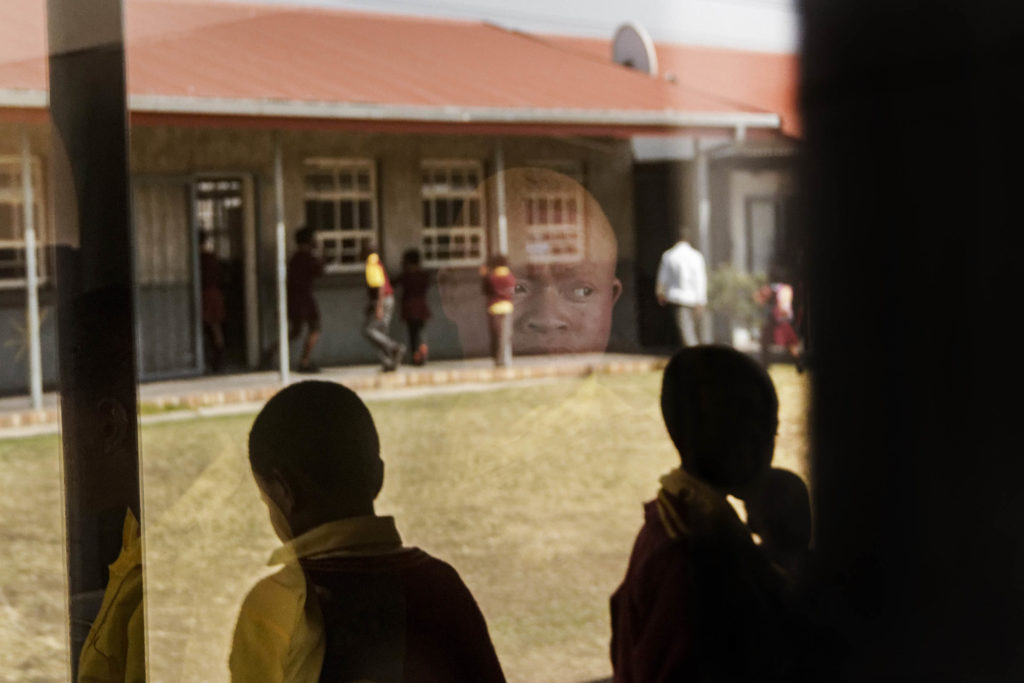 Reflections: A boy with albinism looks pensively out into a schoolyard scene. (Tsepo Gumbi)
Reflections: A boy with albinism looks pensively out into a schoolyard scene. (Tsepo Gumbi)
If one considers Vally’s arguments, on March 21 1960, Sharpeville became something of an unlikely site of struggle. During an anti-pass protest led by the Pan Africanist Congress (PAC), police massacred the protesters that gathered to take part. The historical accounts say 69 people were killed and 180 were injured when police shot at a crowd of unarmed demonstrators. The protestors, it is claimed, rushed the police station en masse. The organisation leading the protest would later be blamed for the incident, not the apartheid state and its racist policies.
Little about the Sharpeville massacre has been resolved. The number of casualties is still disputed and none of the police who pulled the trigger have ever been held accountable.
The story of the massacre has seldom been told by its residents. For the most part, they are treated as victims in a tale that has since had several “corrective” versions in the form of books and other material.
In the prevailing images, we see black people run. Young, old, they run. Or lie dead or wounded from the onslaught of gunfire.
The stigma of victimhood cast upon the place is difficult to reckon with, even as an outsider. One can’t help but wonder how a place, 60 years later, reckons with being reduced to one man-made, cataclysmic event. How much heavier is the weight of it all when partisan politics come into play?
The images and videos of the day and, indeed its aftermath, are for the most part dim and grim. Now, as in 1960, justice remains elusive and the wounds of deferral forever bare.
Given this backdrop of Sharpeville as a river of tears, Tsepo Gumbi’s collection of photographs become an intervention — urgent, yet tender.
Through Gumbi’s lens, we hardly encounter wide expanses or aerial depictions of Sharpeville. We see, instead, contained scenes that jolt our focus and disrupt our expectations. As Gumbi gives us few geographical markers and no easy signifiers of political epoch, we are left with a Sharpeville of our own making. Election posters, instead of anchors of era, become mere markers of continuity.
 Gumbi’s photo from beneath a trampoline captures the children’s joyful abandon. (Tsepo Gumbi)
Gumbi’s photo from beneath a trampoline captures the children’s joyful abandon. (Tsepo Gumbi)
There is beauty, laughter and verve in Sharpeville, Gumbi’s camera declares. In his notes setting out his approach, the photographer states: “I grew up in Sharpeville unaware that it had a politically significant history. It was only in my late teens that I was exposed to books which had sections dedicated to the Sharpeville massacre. The image on the front cover of a book titled An Ordinary Atrocity: Sharpeville and Its Massacre by Philip Frankel, haunted me for a very long time. After several readings, I noticed a lack of contemporary visual material about Sharpeville. I took it upon myself to visually document Sharpeville as I know it. For the past few years, I have dedicated my photography practice to this cause.”
Gumbi’s first love was painting, but he got into photography in 2010 after working at a bank. The desk job didn’t sit well with him, and the art schools he wanted to enrol in had no openings. An acquaintance referred him to the Market Photo Workshop in Johannesburg and thus began his work.
“I didn’t like the fact that around March 21, everything was about Sharpeville, Sharpeville, Sharpeville and for the rest of the year things went quiet. There was no two ways about it: all my assignments, one way or the other had to be about Sharpeville,” he says.
Gumbi set out to produce “a set of photographs that depict the social landscape of Sharpeville; re-imaging the township with a contemporary vibrancy and creativity without discarding its historical significance”.
In many cases, he achieves this through empathetic and, in some cases, abstract interpretations of his surroundings. Gumbi resists the impulse to perform the story of Sharpeville, a stance shaped by his recognition of his outsider/insider status (he no longer lives there).
The complexity, nostalgia and alienation that characterise Gumbi’s relationship with Sharpeville mostly finds expression through children. “I have filled some of the frames with traces of my childhood memories,” he says. “The reality was at times too hard to witness.” As if to counter the indelible, black and white images of adults running to their deaths, he offers us images of fleeting oblivion in colour.
Flâneur and voyeur, the photographer turns his back on his peers for long stretches, as if seeking the innocence of his past. In one doubly-exposed image, he captures a scene of youngsters practising their dance moves. The image is dreamy, softened by the afternoon sun and striated by his vantage point from beyond the school fence.
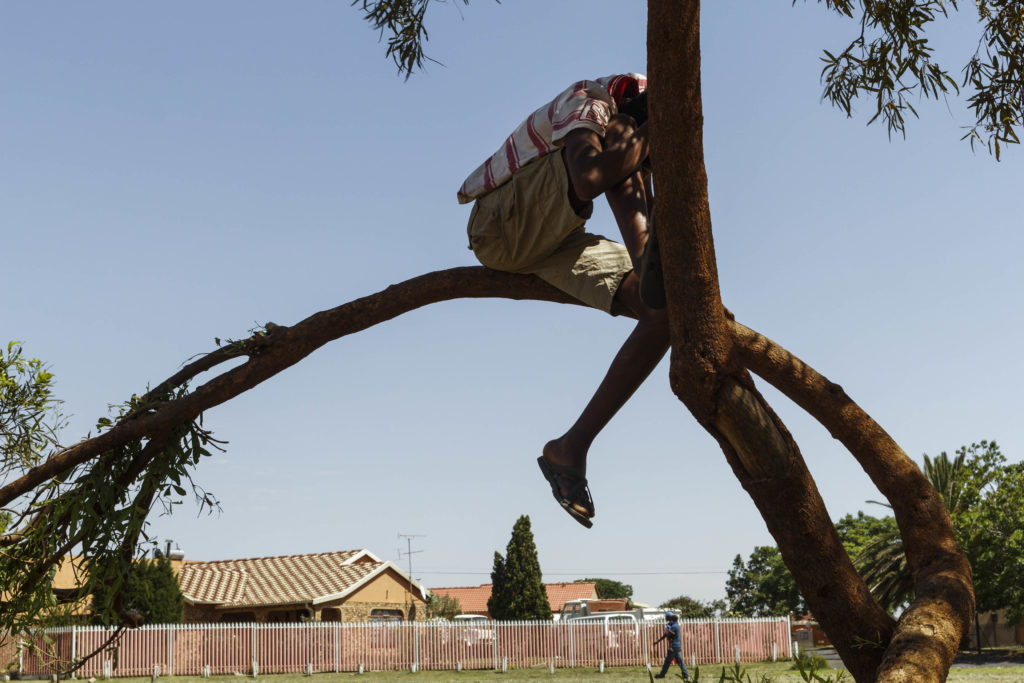 Re-Imagining Sharpeville is a visual investigation of contemporary Sharpeville. Seeking to explore themes and subjects that are overshadowed by historic Sharpeville, Re-Imagining Sharpeville examines the township with a fresh vibrancy and creativity, without losing the integrity of its historical significance.
Re-Imagining Sharpeville is a visual investigation of contemporary Sharpeville. Seeking to explore themes and subjects that are overshadowed by historic Sharpeville, Re-Imagining Sharpeville examines the township with a fresh vibrancy and creativity, without losing the integrity of its historical significance.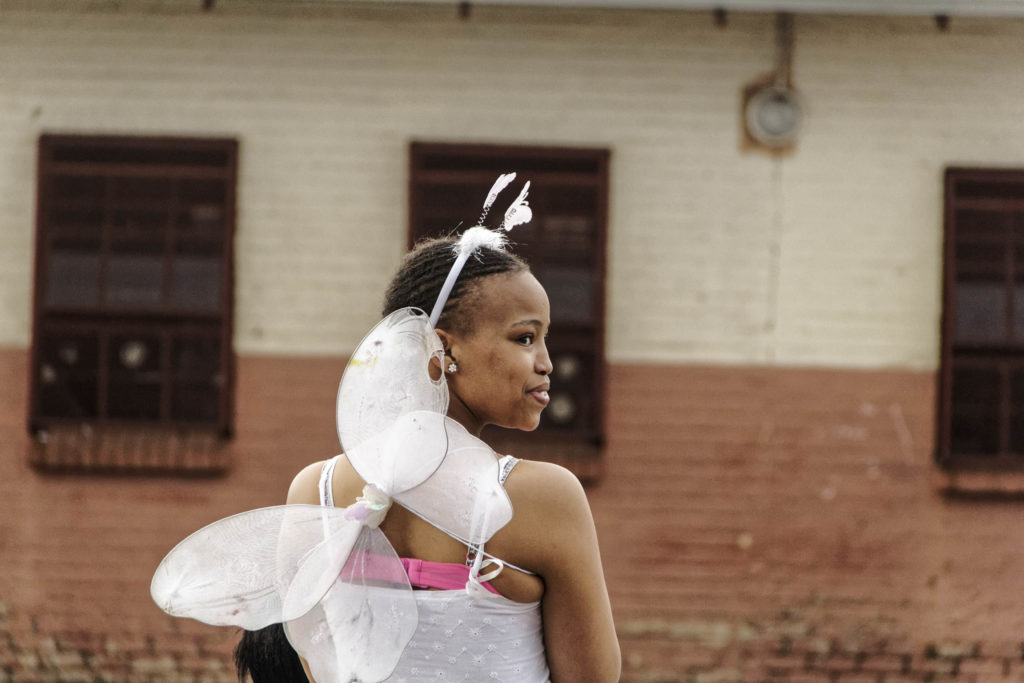
Children at play: There’s magic too in being a fairy and children everywhere climb trees. (Tsepo Gumbi)
In another image, he captures children playing on a tree-lined street. The kids’ surroundings, of paved roads and the browning lawns, could be suburban. Through Gumbi we become participants, like another child perched upon a tree, with a view of the freshly-mowed grass, shrubbery and the shade of trees. But if you look closer at the children playing magusha, a hopping game usually played with tied-up stockings, you will see that they have improvised their prop out of crime scene cordon tape. From the photographer, it’s a recognition of the fact that, regardless of the annual political show of compassion, children have to carry on with the business of being children, claiming their space in the fabric of Sharpeville’s political milieu.
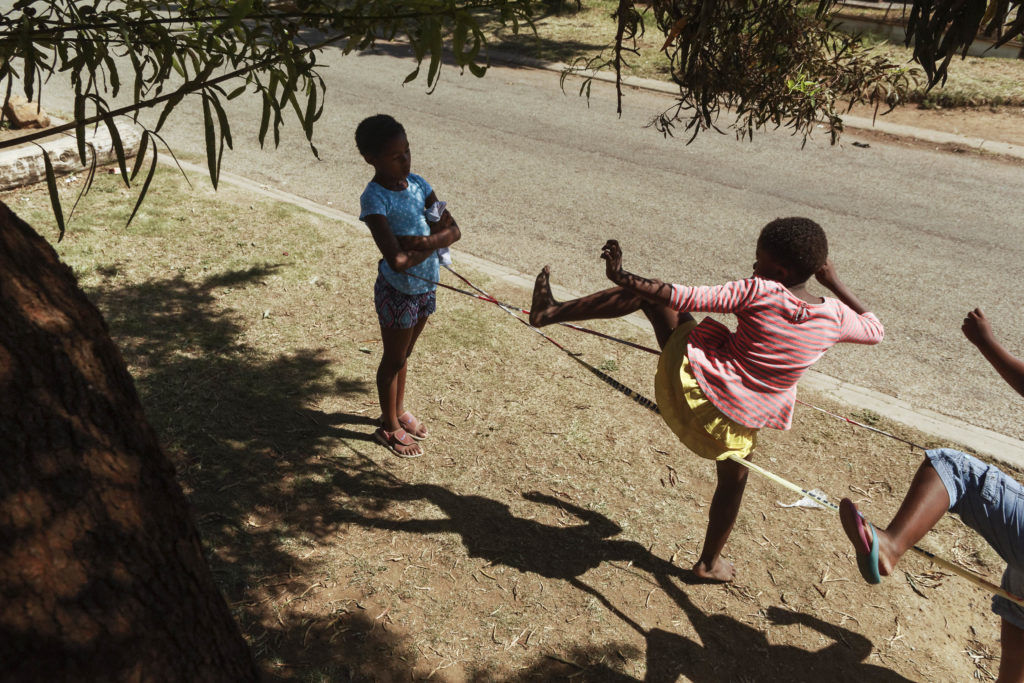 A popular game is magusha, being played with cordon tape; pantyhose is usually used. (Tsepo Gumbi)
A popular game is magusha, being played with cordon tape; pantyhose is usually used. (Tsepo Gumbi)
The innocence embodied by Gumbi’s youthful subjects is hard won. An image of a trio playing on a trampoline captures all of their abandon. Photographed from beneath its springs, so that the children are partially visible through the cylindrical spirals, Gumbi glimpses an exhilaration inseparable from danger as they double bounce each other close to a garbage patch that dominates the bottom right-hand corner of the image.
Obliquely, the image suggests joy as a form of resistance to the “palliative effect” at the heart of Sharpeville’s founding myth. It’s not that the children are blind to the dump site so close to them. It is, after all, their inheritance from the Sharpeville Six. The Sharpeville Six were given death sentences in 1985 after their arrest during a rent protest in which Duma Dlamini, the township’s deputy mayor, was killed. Their sentences were later commuted.
Sharpeville’s relationship with power continues to be displayed by the manner in which the massacre is perennially memorialised. Gumbi does not shy away from confronting this. Out of a collection of 35 images, two place us in a politically definable era. One depicts a red brick wall with a torn election poster stubbornly hanging on. The poster bears the image of Jacob Zuma, who will soon fall out of favour with his political party and much of its constituency. His dismembered face smiles into a void. “There is development in Sharpeville, but not like what you would expect,” says Gumbi, sketching out Sharpeville’s political profile. “The reason for that is its proximity to Johannesburg. Soweto and Sharpeville are two of the most famous townships in South Africa, historically. But if you compare the two, Sharpeville is nowhere. Politicians like to do something where the media can see it happening. Sharpeville is remembered at this time, typically, which irritates us.”
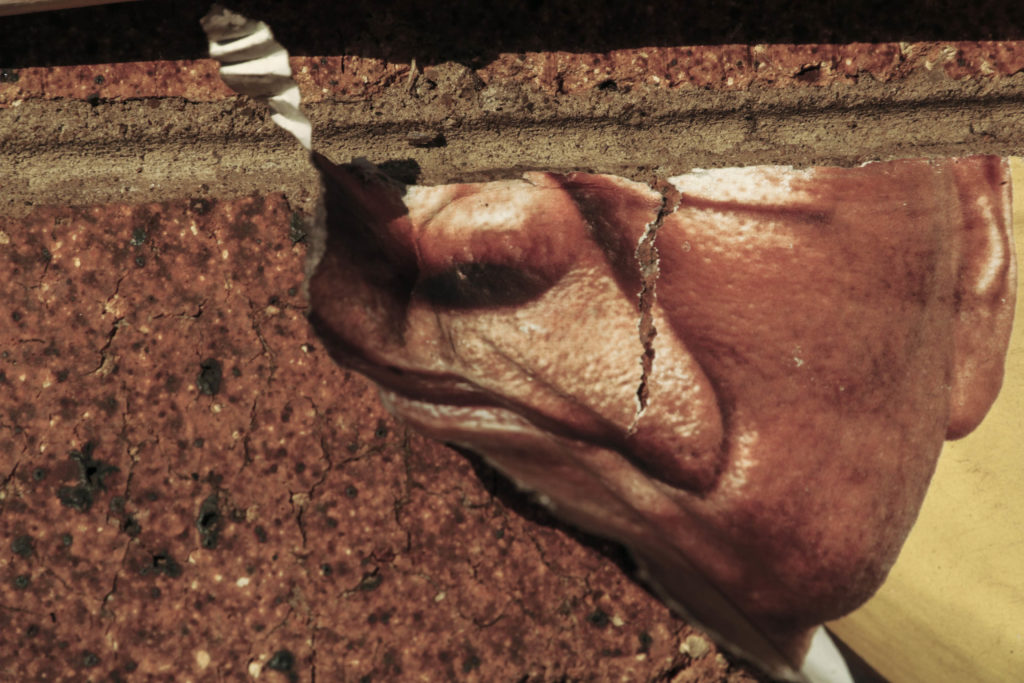 A torn election poster of Jacob Zuma stubbornly hangs on, much as he does in the here and now. (Tsepo Gumbi)
A torn election poster of Jacob Zuma stubbornly hangs on, much as he does in the here and now. (Tsepo Gumbi)
In other collections of Gumbi’s photographs, such as A Place Called Sharpeville and Front Seat, his sentiments about Sharpeville being Soweto’s neglected cousin are made more obvious. In Re-imagining Sharpeville the squalor is usually pushed to the background. “I was tempted [for a long time] to go back to Sharpeville but I thought it would be too familiar,” says Gumbi of the project’s protracted gestation. “Eventually I thought, let me be a visitor in Sharpeville but not produce images that a tourist would.”
Gumbi’s instinctive familiarity with the township enhances the sense of wonder palpable in his work.
Interestingly, the only images depicting physical violence in this collection are those where it is reenacted. We see Sharpeville as a site of industry and entertainment rather than a place of dour commemoration.
Although the victims and survivors of the Sharpeville massacre are absent from Gumbi’s frames, they hover. The ghost of the township’s bloody past is somewhat visible. In his approach, though, we see a new Sharpeville, freed from the usual squabbles spurred by party politics. The PAC commemorates the day as Sharpeville — Langa Day while the ANC has sat over an administration that oversaw the change to Human Rights Day. Gumbi, through the power of photography, liberates Sharpeville from the weight of history. Through him, we see a problematising of a place that has been so singularly defined as to be unknowable.
Tsepo Gumbi’s book Re-imagining Sharpeville is due out later this year